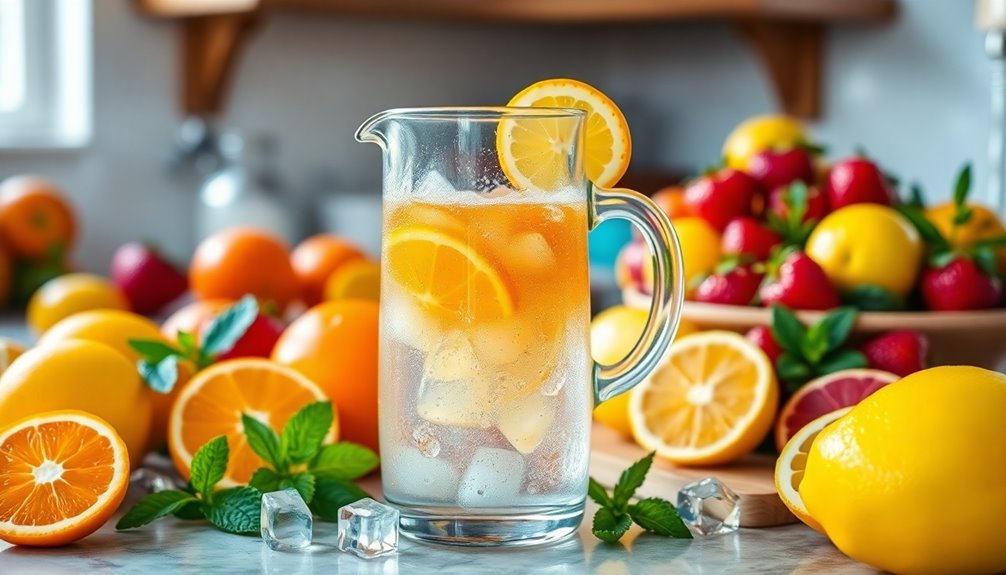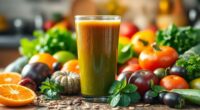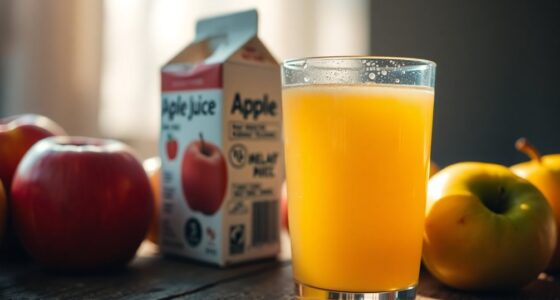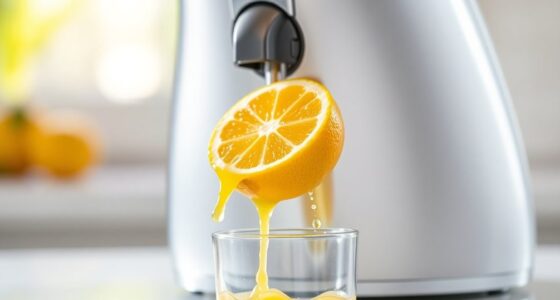To make fizzy juice, mix 11.5 ounces of thawed frozen juice concentrate with 33.8 ounces of seltzer water in a pitcher. Stir gently to keep the carbonation intact. Serve it right away to enjoy the refreshing sparkle. You can customize the flavor by adjusting the juice concentration or trying different juice-seltzer combinations. It's a fun, cost-effective way to impress guests at gatherings. Stick around if you want to learn about pairing options and creative twists!
Key Takeaways
- Combine 11.5 ounces of thawed juice concentrate with 33.8 ounces of seltzer water in a pitcher for a fizzy base.
- Stir gently to mix, avoiding vigorous shaking to maintain carbonation and sparkle.
- Serve immediately for the best taste and effervescence, enhancing your dining experience.
- Customize flavor by adjusting juice concentrate and experimenting with different juice and seltzer combinations.
- Enjoy a budget-friendly, homemade alternative to store-bought sparkling beverages for special occasions.
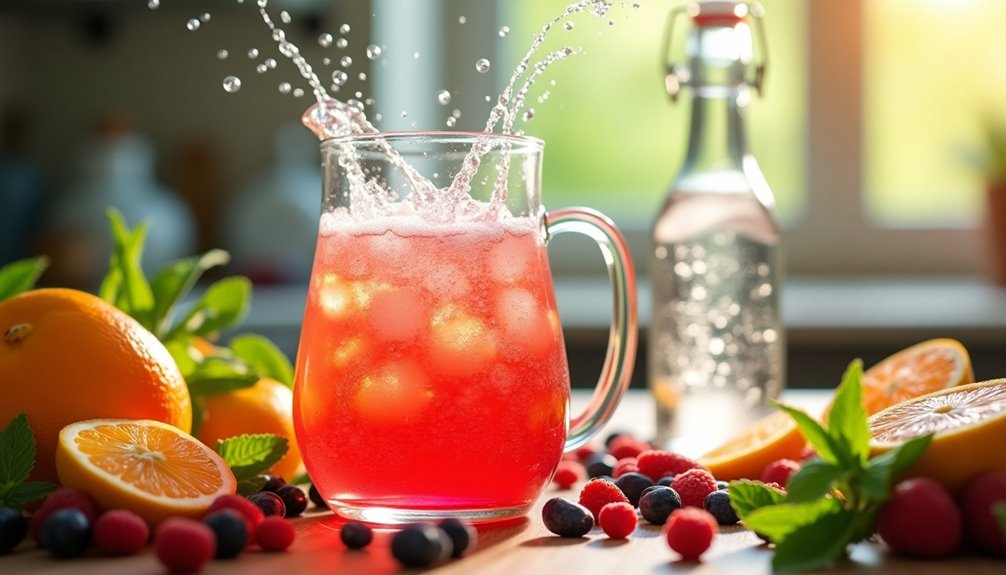
If you're looking to add a refreshing twist to your beverages, making fizzy juice is a simple and fun way to do it. You don't need to spend a fortune on store-bought fizzy drinks when you can whip up your own delicious concoctions at home. This process isn't only easy but also allows you to customize the flavors to suit your taste. So let's dive into how you can create your own fizzy juice, complete with that delightful bit of fizz that everyone loves!
To start, gather your ingredients. You'll need 11.5 ounces of thawed frozen juice concentrate—choose any 100% juice that you enjoy. Popular choices include cranberry, grape, or even a mix like cran-raspberry or apple-raspberry.
Once you've selected your juice, you'll also need 33.8 ounces of seltzer water. If you want to get a little creative, you can substitute flavored mineral waters or club soda for the seltzer, giving your fizzy juice a unique twist. Just imagine the taste of fresh cranberry juice combined with a lemon-lime club soda—years ago, such a combination would have seemed like a culinary dream!
Now, grab a pitcher and combine the thawed juice concentrate with the seltzer water. Stir gently to mix the two without losing too much carbonation. You want to keep that carbon dioxide intact; that's what gives your drink that refreshing sparkle.
It's essential to be a little careful during this step. If you're too vigorous in your mixing, you might end up with a flat drink instead of the fizzy delight you're aiming for. So take your time, and you'll have a fizzy drink that's both vibrant and flavorful.
Once your fizzy juice is ready, it's best to serve it immediately to maintain that refreshing taste and effervescence. Pair it with spicy foods like Mexican cuisine or even a classic pizza for a delightful experience that tantalizes your taste buds. The fizz adds an extra layer of enjoyment, making every sip a little bit more exciting.
Homemade fizzy juice is also a cost-effective alternative to store-bought sparkling beverages, especially during special occasions or family gatherings. You can impress your guests with your mixology skills while keeping things budget-friendly.
Plus, you can make it as sweet or tart as you prefer, adjusting the juice concentrate to match your personal taste. Whether you like it with a hint of citrus or a more pronounced berry flavor, experimenting with different combinations can lead to a delightful and refreshing drink. Additionally, if you’re curious how to prepare jungle juice, it’s simple to create a large batch for parties or gatherings. Just mix your chosen juices, alcohol, and some fresh fruit for added flavor and a festive touch!
Frequently Asked Questions
How Is Fizzy Juice Made?
Fizzy juice is made by mixing juice concentrate with carbonated water.
You'll start by thawing about 11.5 ounces of your favorite frozen juice concentrate.
Then, combine it with roughly 33.8 ounces of seltzer or flavored mineral water.
Pour the seltzer slowly into the juice to avoid excessive bubbling, and stir gently to mix.
This method creates a refreshing, bubbly drink that's perfect for any occasion!
Enjoy your homemade fizzy creation!
How to Make Your Juice Fizzy?
You might wonder how to elevate your juice game with some fizz.
Start by mixing thawed frozen juice concentrate with seltzer water. Pour the seltzer slowly to keep those bubbles intact.
Feel free to experiment with different 100% juices like cranberry or grape, or even flavored mineral water.
If you want to get creative, you could use a Soda Stream to carbonate your favorite juice.
Enjoy your refreshing fizzy creation right away for the best experience!
What Are the Ingredients in Fizz Juice?
To make fizz juice, you'll need a few key ingredients.
Start with 11.5 ounces of thawed frozen juice concentrate made from 100% juice as your flavor base.
Then, add 33.8 ounces of seltzer water or carbonated water for that fizzy kick.
You can choose any 100% juice, like cranberry or grape, and feel free to enhance the flavor with mineral waters or homemade sodas.
Enjoy it fresh for the best taste!
How to Make Fizz Drink at Home?
Ready to tickle your taste buds? Making a fizzy drink at home is a breeze!
Just grab some chilled seltzer water and your favorite juice. Pour them into a pitcher, mixing gently to keep that delightful fizz.
You can also switch it up with flavored mineral water or even a Soda Stream for a bubbly twist.
Serve it right away to enjoy the refreshing sparkle—your friends won't be able to resist!
Conclusion
Now that you've mastered the art of making fizzy juice, you can enjoy a refreshing drink that's sure to tickle your taste buds. With just a few simple ingredients and steps, you're ready to impress your friends and family. So, pop that bottle of sparkling water and let your creativity flow! Remember, the world's your oyster when it comes to flavors, so don't be afraid to experiment. Cheers to your fizzy creations!
Cindy thoroughly researches juicing trends, techniques, and recipes to provide readers with practical advice and inspiration. Her writing style is accessible, engaging, and designed to make complex concepts easy to understand. Cindy’s dedication to promoting the advantages of juicing shines through her work, empowering readers to make positive changes in their lives through the simple act of juicing.

